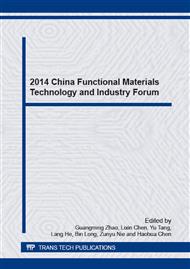p.750
p.757
p.764
p.770
p.781
p.787
p.793
p.800
p.807
Si/SiO2 Composite Negative Electrode Material for Lithium Ion Batteries
Abstract:
As lithium-ion battery anode materials, silicon has the highest specific capacity. In order to restrain pure silicon’s serious volume change and enhance its electrochemical performance, Si/SiO2 composites were prepared by using a convenient high energy ball-milling technique. The characteristics of the composites as anode material for rechargeable lithium-ion batteries were investigated by X-ray diffraction and scanning electron microscopy methods. The electrochemical performance of the anode material was studied, and it was found the composite anode had a high capacity of 1333 mAhg-1 in the first cycle and 400 mAhg-1 could still be obtained after 46 cycles. Such prepared materials displayed improved cycle life.
Info:
Periodical:
Pages:
781-786
Citation:
Online since:
December 2014
Authors:
Price:
Сopyright:
© 2015 Trans Tech Publications Ltd. All Rights Reserved
Share:
Citation:


